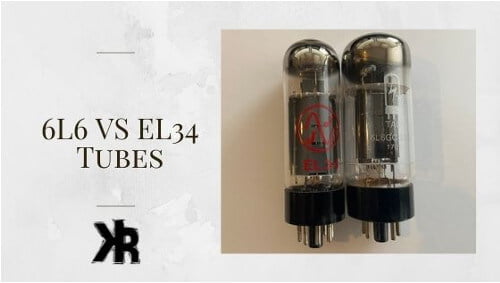Table of Contents
There are several power tubes available for guitar and bass amps, but two stand out the most. The 6L6 and EL34 tubes have been rivals for many years, but what’s the difference?
The main difference between the 6L6 and EL34 tubes is that they have different sounds. The EL34 is much more scooped sounding and doesn’t have the same amount of headroom that the 6L6 offers. The electrical operating requirements also differ.
In this Killer Rig article, we’ll take a close look at the 6L6GC and EL34 power tubes. Let’s explore their differences, to see which one is right for you.
Differences Between 6L6 and EL34 Tubes
- Tube Type: 6L6 tubes are beam power tetrodes, while EL34s are pentodes.
- Physical Appearance: Some 6L6 tubes are short and fat, while the EL34 is slightly taller.
- Sound Characteristics: EL34 tubes sound darker and heavier. 6L6 tubes sound brighter and fuller.
- Headroom: The 6L6 has more headroom, meaning they sound cleaner at higher volume compared to EL34 tubes.
- Voltage and Current: EL34 tubes are generally powered with higher voltages. But the 6L6GC conducts more current.
- Clipping: The EL34 generally breaks up softer, which, in some amps, will sound nicer and is why they are popular.
The 6L6 and El34 are power tubes that were originally designed for use in radios. They have been used in many types of devices over the years, including guitar amps.
The 6L6 is a beam-power tetrode that was first introduced in the 1930s. It was designed by RCA engineers to be used in electronic devices. The EL34 is a pentode power tube that was developed by Philips in 1949.
Physical Differences
In this particular case, we will be comparing the 6L6GC model to the EL34. They are more commonly used with instrument amplification.
When placed next to each other, the 6L6GC is noticeably wider than the EL34. It looks like a beefier tube and is not as skinny. But this is primarily due to a wider glass envelope.
The EL34 is slightly taller than the 6L6GC, but it is maybe only by an eighth of an inch. Based on these two differences, it would be safe to say that there are no physical limitations to size. Especially when putting them into an amplifier.
The 8-pin configuration is the same, but, the EL34 has one extra. Pin 1 on the 6L6GC is missing, as it is connected internally. The EL34, on the other hand, will need this pin to be connected to the amplifier’s circuitry.
But any amplifier that is designed to use these two tube types will have this already taken care of.
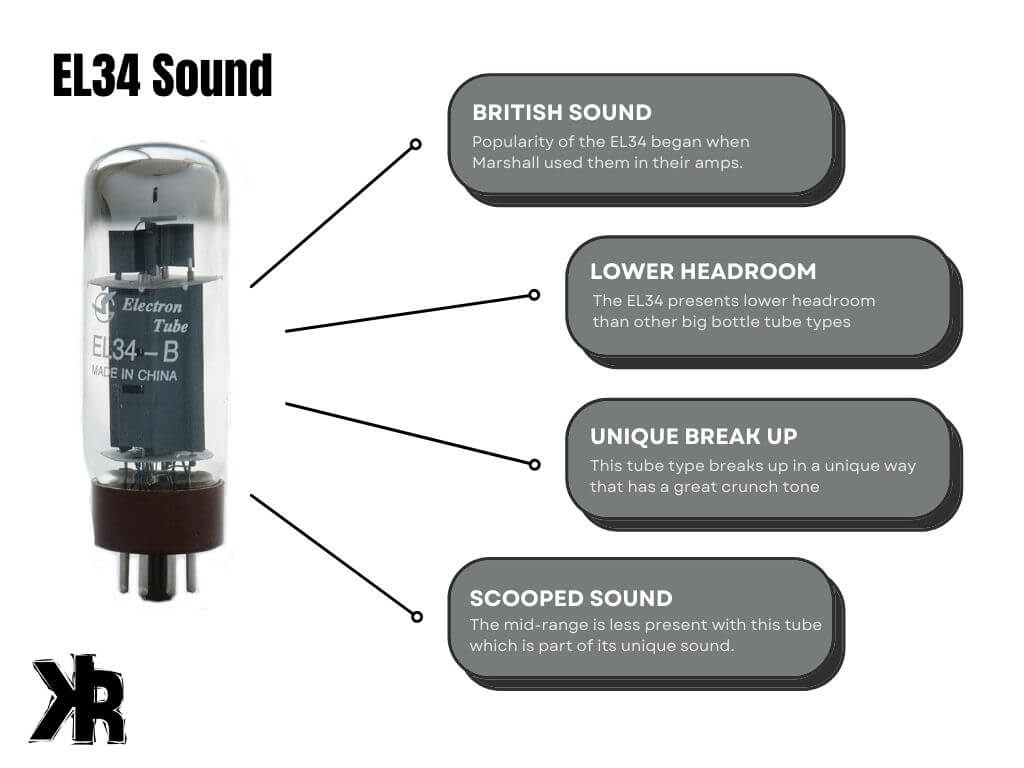
Electrical Differences
Electrically, the EL34 and 6L6GC are very different tubes. They have different normal operating and limiting values. But they also respond uniquely when a signal is applied to their grids.
They can be used with similar power supplies. But do have some differences when it comes to maximum voltage.
This chart is a comparison based on the JJ brand tube types:
| Maximum Specifications | 6L6GC | EL34 |
|---|---|---|
| Plate Voltage (Anode) | 500 | 800 |
| Screen Voltage | 450 | 450 |
| Wattage | 30 | 25 |
| Heater Current | 900mA | 1.5A |
The data sheets can be found here:
The plate impedance requirements for each tube type are also different. So the output transformer needs to be made accordingly. As well as a bias voltage that if too high will not reach the right dissipation.
Sound Differences
The biggest difference between the 6L6 and EL34 tubes is their sound. The 6L6 has a warm, full-bodied tone that is well-suited for blues, country, rock, and metal. This is normally referred to as an American tone in the guitar music communities.
This is primarily because of the higher headroom. Also, the more present midrange offers a more versatile, yet full sound. It’s also because Fender, being an American company, used the 6L6 tube type in their amps.
They are also bright sounding, which is great for clean tones as well as high gain.
The EL34 has a more scooped tone that is often described as being bass-heavy. The EL34 became a popular tube in Marshall amps and was referred to as more of a British sound.
Many popular rock bands used these vintage Marshall amps. They have formed their sound around them. The EL34 doesn’t have quite as much headroom as a 6L6. So getting a crunch tone from them was easy and part of the magic in the music.
They are also able to work well with the same types of music as the 6L6, they are simply a different sound.
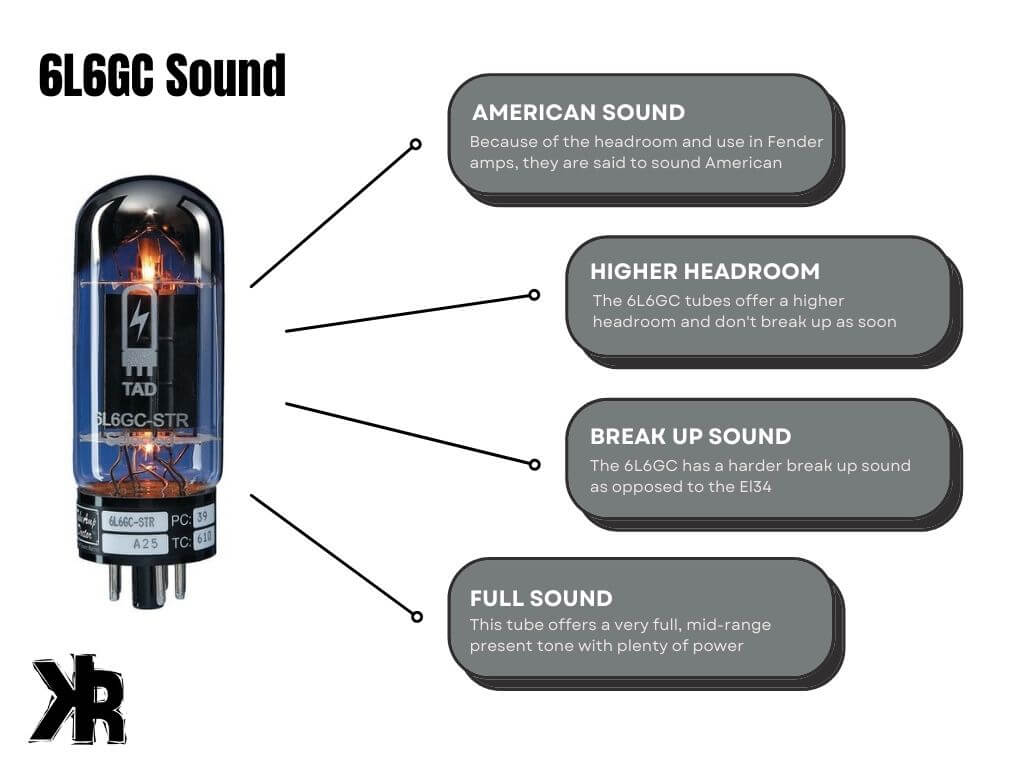
Which One Is Better?
There really isn’t an answer to this question. It depends on what sound you want, as the frequency response is different. If you want that American tone, then the 6L6GC is probably the better option for you.
But it doesn’t stop there, today this tube type is also chosen for rock and metal amps as well.
Popular amplifiers that use 6L6GC tubes are:
- Mesa Boogie Rectifier
- EVH 5150
- Revv Generator
However, if you’re looking for that British Marshall sound, then the EL34 is probably your flavor. This tube type breaks up sooner and also forms a crunchy tone that is all its own. This is also highly desirable and sounds wonderful.
You will find EL34 tubes being used by amplifier brands like Orange, Friedman and Victory among others.
The EL34 can also do some great hard rock and metal tones as well, as it has a scooped sound.
At the end of the day, it comes down to personal preference. Both tubes have a unique sound that can offer something different to your amplifier. It’s really up to you to decide which one you like better.
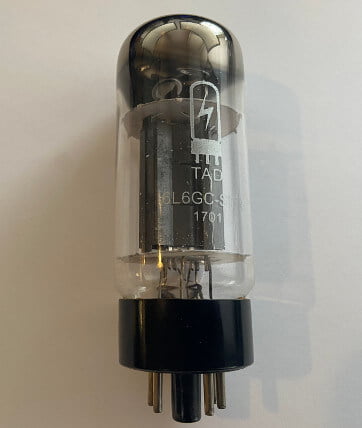
Which One Should You Choose?
When it comes down to it, both of these tube types sound great and have plenty to offer. Your initial selection should be based on the type of music you play.
Do you play vintage rock from the 70s and like to crank your amplifier loud? Then the EL34 is probably going to be more your flavor.
Yet, if you would rather get your distortion sound from a cascaded preamp, you might want to try the 6L6GC. This will allow you to get tons of headroom and a pristine clean sound.
If your amplifier circuit is designed to use both types, then try each one and see what you think of them. You might just end up mixing both, finding a very satisfying sound this way.
We have a great article here about the 5881 vs the 6L6!
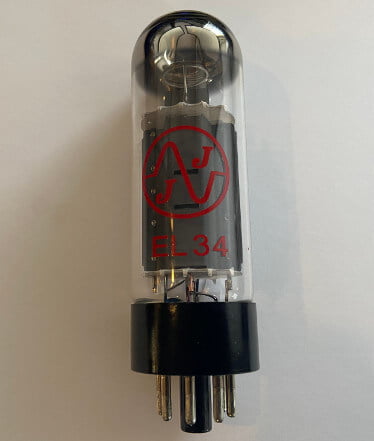
6l6 vs EL34 For Metal?
We see this question asked a lot. When it comes to metal, we feel the 6L6GC is the way to go. Primarily because of the full-bodied sound they provide.
The reason for this choice is that the high-gain tone is created in the preamp. The extra headroom and less scooped sound that a 6L6GC offers will let the preamp do most of the heavy lifting.
Personally, I would rather have a cleaner, loud power section. One that lets the preamp do all the distorting and tone shaping. This is a more modern desire, as when you turn up the volume, it remains clean.
But, tones are subjective, there are many players who prefer the sound of an EL34 metal amp. So it’s probably a good idea to go down to a music store and try a few.
FAQs
Can I use 6L6 instead of EL34?
This depends on the amplifier and if it is designed to use them. The operating parameters are different between the two tube types. So not every amp can use them.
It’s always a good idea to consult your manual. Just make sure changing to a different tube type will not damage your amplifier.
Do EL34 and 6L6 have the same pinout?
They are different by one pin, which means they may not be compatible with some amplifiers.
If your user manual says 6L6 only, this is going to be one of the reasons why. Otherwise, every other pin is identical between them.
Are 6L6 and EL34 tubes interchangeable?
This depends entirely on the amplifier they will be used in. Some amplifiers are made to use many different power tube types. Others, are only designed to use one. Electrically, the 6l6 and El34 are not directly interchangeable.

